Is electric equipment the answer?
25 October 2021
Construction equipment is rapidly evolving to become greener and cleaner. From boom lifts to excavators, Lindsey Anderson reports on the latest advancements in electric power
Around the world, jobsites are seeing an increase in government regulations for low emissions and quiet zones where internal combustion engines are either limited in use or completely banned. In response, manufacturers are designing and producing environmentally friendly machines to meet these requirements.
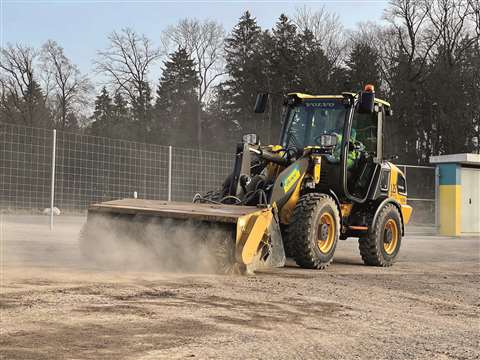 Volvo CE’s L25 Electric in operation clearing roads at an Eberhard, Switzerland site.
Volvo CE’s L25 Electric in operation clearing roads at an Eberhard, Switzerland site.
“The move to electric power is a transition that is gathering speed,” says Åsa Alström, head of strategic communications at Volvo CE, about Volvo’s sustainability initiatives, green equipment and more. “
Government policies and market trends are seeking to reduce the use of combustion engines in both on-road and off-road applications to address climate change and mitigate air pollution.
Construction’s carbon emissions
“Both Volvo Group and Volvo CE have a really strong commitment to meeting the requirements of the Paris Agreement on climate change and reducing carbon emissions. We also see a strong ambition in our customers’ roadmaps towards the reduction of their emissions. Increasing emission incentives and zero-emission targets coming into play in recent years have had a marked effect on the increase in electric equipment.
“Governments, both on a local and country-wide level, are adopting clean air policies, so if contractors want to win these bids, they need to prove that they’re working with equipment with reduced or zero emissions.”
For most contractors who consider the move to electric machines, the biggest challenge is simply a change in mindset for electric equipment.
“Customers must have an adequate charging infrastructure in place to ensure machines operate as planned,” explains Alström. “While a 110-volt set up will charge the units over time, a 240-volt setup is necessary to charge the machines quickly.
“For remote jobsites, a solar array may be necessary to provide power when an electric grid isn’t an option. It is also vital to continue developing our battery offering – an area which Volvo CE is already focusing on with the intention of bringing the benefits of improved battery capacity to our customers.”
Volvo CE has worked over the last few years to introduce battery-electric machines, hydrogen fuel-cell-powered equipment and improved internal combustion engine solutions. The company already has the ECR25 Electric excavator and L25 Electric wheeled loader available to the market, and the company is currently in a customer pilot phase with its 22-ton EC230 Electric mid-size excavator and the EC55 electric excavator.
“Customers can expect further electric solutions to be commercialised in the coming months and years,” Alström says. “As part of our firm commitment to shift towards electric, Volvo CE has also set a target for 35% of all vehicles sold to be electric by 2030. It is aligned with our industry leading ambition to reach net zero value chain greenhouse gas emissions by 2040, a pledge validated by the Science Based Targets initiative.”
While larger electric equipment is being engineered and debuted, one sector has been producing electric-only machines since the mid-1990s: the access industry.
Access industry and electric equipment
JLG Industries is one such pioneer. In 1994, the world’s largest manufacturer of access equipment debuted the first, all-electric boom lift, shortly followed by the only fuel-cell powered boom lift in 1999, and in 2014, JLG introduced the first true hybrid diesel/electric boom lift, the H340AJ.
“The aerial equipment market has changed in the last few years,” says Jennifer Stiansen, director of marketing, JLG. “In the past, equipment owners wanted mobile elevating work platforms powered by the biggest, most powerful internal combustion engine that an individual machine model could support. In general, the more power a machine delivered, the better.
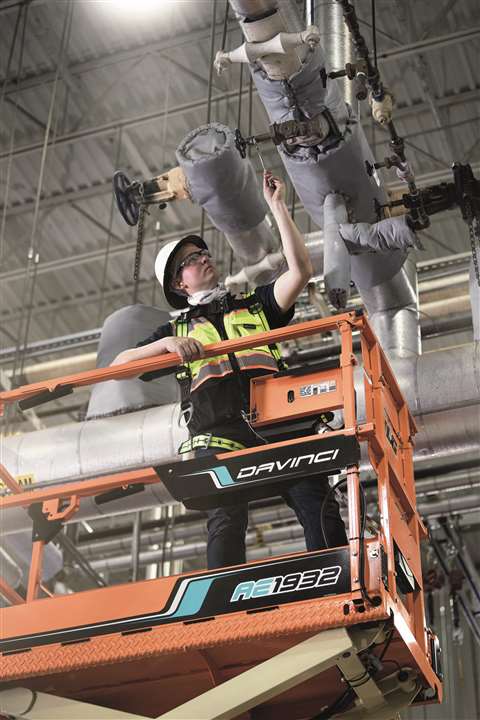 JLG’s new hydraulics-free, all-electric DaVinci AE1932 scissor lift – an industry first.
JLG’s new hydraulics-free, all-electric DaVinci AE1932 scissor lift – an industry first.
“But today, that has changed. More stringent Tier IV Final engine regulations have made engines more complex, including the addition of a DPF in most models over 74hp. Combined with stricter environmental standards around the world, we are seeing a shift towards purchasing machines with just enough engine power and/or a switch to hybrid engine/battery or exclusive battery power where feasible.”
JLG says it is seeing an increase in demand for greener and more versatile machines not only for their environmental benefits, but also for the desire to reduce total cost of ownership (TCO).
All-electric scissor lifts, for example, will lower overall TCO by 30-40%, the company says, a figure arrived at by reviewing thousands of rental company maintenance records and Rouse resale values compared to the expected parts replacements and operational benefits that equipment models like the JLG DaVinci lift bring.
Additionally, Tier V engine regulations in Europe will further advance the cost of engine technology at a time when lithium-ion battery costs are coming down.
Lithium-ion battery technology
In early February, JLG’s parent company Oshkosh Corporation invested US$25 million into Microvast, a developer of lithium-ion battery technology for commercial and specialty electric vehicles. The announcement was made more than a year after JLG formally debuted its hydraulics-free, all-electric DaVinci AE1932 scissor lift.
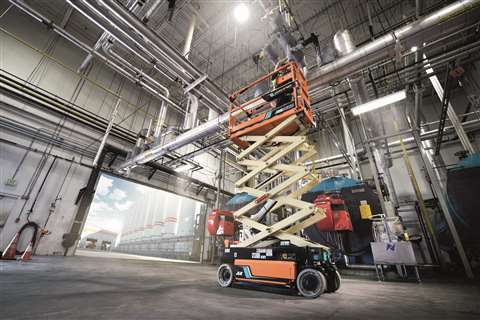 The DaVinci is powered by a single 24-volt lithium-ion battery that can be fully charged in 3.5 hours.
The DaVinci is powered by a single 24-volt lithium-ion battery that can be fully charged in 3.5 hours.
The DaVinci is powered by a single 24-volt lithium-ion battery that can be fully charged in 3.5 hours. If the battery runs out of juice and more power is needed, it can be charged for five minutes to get 100 feet of drive and enough torque for loading. JLG says the battery has a ten year lifespan and requires no maintenance.
“We believe that the market will continue to see momentum shift towards electrified products in environmentally sensitive and indoor applications,” Stinasen says. “We also believe that more advanced solutions are on the horizon.
“Again, take our DaVinci scissor lift. It’s the first fully electric scissor on the market. The lift, steer and drive systems are all fully electric, with zero hydraulics and every component optimized to either conserve energy or to deliver energy back to the battery for optimal performance on a single charge. Electrifying parts of these machines is nothing new — but utilizing all-electric components with a lithium-ion battery is new. It is a game changer for the industry.”
In August this year US-based Twin Metals Minnesota built on its commitment to advancing the nation’s “most sustainable and technologically advanced underground mining project” by investing in the electrification of its mining and support vehicle fleets. The company said implementing battery electric vehicle technology is its latest effort to reduce its project footprint and further minimise environmental impacts.
“Today, we are committing to use the very technologies combatting climate change that require the metals our world-class, 21st century mine will produce,” says Twin Metals CEO Kelly Osborne. “We’re doubling down in our fight against climate change by both delivering the raw materials needed for our clean energy future and using the most innovative technologies to reduce the impacts of our own operations.”
Converting the mine’s fleet from the previously proposed diesel equipment to electric vehicles will reportedly allow Twin Metals reduce its onsite greenhouse gas emissions by 65%. Additional benefits noted by the miner include a decrease in power requirements for underground ventilation and heating; a reduction in maintenance needs; noise reduction; and improved worker safety and air quality.
“Battery electric mining equipment has advanced significantly since the technology was first introduced just over ten years ago, and it will only continue to improve as Twin Metals gets closer to becoming operational,” says Glenn Barr, Twin Metals vice president of Project Development.
“This is an incredibly exciting time for the mining industry as we work to advance cutting-edge technologies that can greatly reduce our industry’s footprint, and we’re proud that Twin Metals is at the forefront of this shift toward sustainable, innovative mining practices.”
Battery electric vehicle technology
Twin Metals is expected to be the first mine in the state of Minnesota to adopt battery electric vehicle technology. The planned electric vehicle fleet represents nearly 100% of the mining and large support vehicles for the project. Twin Metals has not yet established contracts with specific battery electric mining equipment vendors.
In the same vein, Caterpillar signed an agreement in June with Nouveau Monde Graphite for the OEM to develop, test and produce zero-emission machines for the Matawinie graphite mine in Canada. The companies hope that Caterpillar will become the exclusive supplier of an all-electric mining fleet for deployment at the Matawinie mine by 2028.
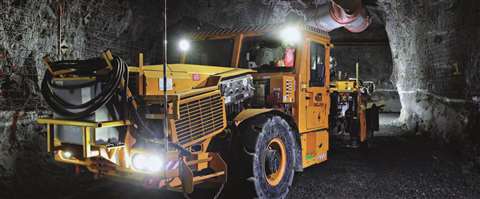 A battery-electric MacLean BT3 boom truck as photographed in a mine by James Hodgins, Mining Industrial Photographer.
A battery-electric MacLean BT3 boom truck as photographed in a mine by James Hodgins, Mining Industrial Photographer.
Arne H Frandsen, Chairman of Nouveau Monde, commented, “Alongside Caterpillar, which in my opinion is the most trusted and reputable supplier of heavy-mining equipment worldwide, we can bring the zero-emission machines vision into reality.
“I think it is remarkable that Nouveau Monde, as a representative for the new style green resources industry, is part of spearheading the electrification of the industry, by collaborating with Caterpillar.”
Another mining fleet first, announced in July, came from Epiroc, a Swedish supplier to the mining and infrastructure industries, who said it won a significant order for battery-electric mining equipment from Ivanplats for a green field mine in South Africa.
Ivanplats, a subsidiary of Canadian mining company Ivanhoe Mines, has ordered several Boomer M2 Battery face drill rigs and Scooptram ST14 Battery loaders. The new Platreef underground mine, which will trial the emissions-free machines during its initial development phase, will produce palladium, rhodium, platinum, nickel, copper and gold. Ivanplats is aiming to use all battery-electric vehicles in its mining fleet at Platreef.
The order exceeds SEK 90 million (US$10.4 million) in value and was booked in the second quarter 2021, Epiroc said.
“It is encouraging that Ivanplats is considering going all battery-electric at Platreef, and we are proud to support them on this journey,” said Helena Hedblom, Epiroc’s president and CEO. “Battery-electric equipment is increasingly embraced by mining companies as it provides a healthier work environment, lower total operating costs, and higher productivity. The technology is now well established, and Epiroc is driving this change toward emissions-free mining.”
Boomer M2 Battery face drill rigs and Scooptram ST14 Battery loaders are built in Sweden and are scheduled for delivery in early 2022. Epiroc will also provide on-site operator and maintenance training to Ivanplats.
Epiroc said it will offer its complete fleet of underground mining equipment as battery-electric versions by 2025, and its full fleet for surface operations as battery-powered versions by 2030.
Electric excavator
China-based OEM Shandong Lingong, also known as SDLG, debuted a range of energy-saving products in early August, including the E660F-Ex electric excavator, the L968H-HST hydro-static wheeled loader and E6500F-HB hybrid excavator.
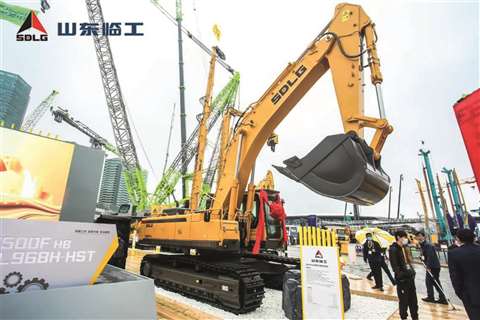 SDLG says it is committed to producing ‘greener’ construction equipment.
SDLG says it is committed to producing ‘greener’ construction equipment.
The E660F-Ex pure electric excavator uses advanced lithium battery technology. It can achieve zero emissions, reduce noise levels by 12 decibels, and reduce operating costs by a third compared with traditional products, according to the company.
“Compared with diesel driven products, pure electric products have lower noise and lower vibration, which means the driver’s driving experience will be qualitatively improved,” said Wang Xiaohui, general manager of SDLG Import and Export Company.
Wang Xiaohui adds that the electric excavator was more suited to work in confined spaces and urban environments and also had faster acceleration at low speeds than its diesel counterpart.
During the 2020 Shanghai Bauma Exhibition, the fourth-generation energy-saving product, L968H-HST hydrostatic wheeled loader and E6500F-HB hybrid excavator were first unveiled.
“These two products represent the two technical solutions of SDLG’s fourth-generation energy-saving technology,” added Chi Feng, chief engineer of SDLG.
Speaking to the trends, Fredrik Åkesson, product portfolio manager for rollers at compact equipment OEM Dynapac, says the company has seen electric and battery power being applied to mini excavators, skid steer loaders, access equipment and site dumpers. He adds that they have been widely welcomed by forward-thinking and environmentally-aware rental fleet operators and contractors.
Dynapac electric tandem roller
In July, Dynapac developed a “first of its kind” electric tandem roller, as part of its new Z.ERA initiative to eliminate emissions. The CC900 e electric double-drum vibratory roller, which is currently being field-tested in Sweden, weighs 1.6 tonnes and has an operating drum width of between 0.8 and 1.0 metres.
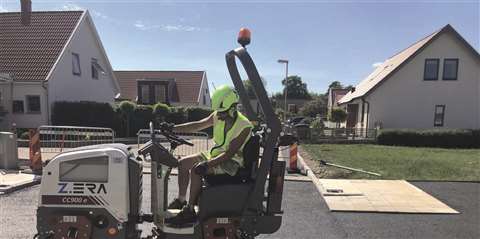 The Dynapac CC900 electric tandem roller.
The Dynapac CC900 electric tandem roller.
Åkesson says, “With the development of the CC900 e, Dynapac has taken a massive technological step. We are proud to be the first realizing this from an “exhibition concept” machine into something we now have on the field. That step sets our customers on the path to a zero emissions future.
“The only thing missing has been an electric-powered tandem vibratory roller to run alongside these other zero emissions machines,” Åkesson says.
The company, which is soon to begin field-testing its new CC1000 electric vibratory roller with input from rental company Loxam, said the design of the CC900 e roller is based on the diesel-powered Dynapac CC900 series equipment range.
The CC900 e has an operating drum width of between 0.8 and 1.0 metres and offers a centrifugal force of 16.7kN.
While the CC900 e tandem roller is not anticipated to be available on the construction equipment market until 2022, according to Dynapac it will initially be produced in a limited number.
In development for over year, work on the electric-powered model was done in collaboration with construction contractor Skanska.
Åkesson said, “Co-operation is the key to developing a successful product and direct user input is incredibly valuable to a project of this kind. From the user perspective, it is equally important to be acquainted with the equipment at an early stage.
“Even though the compaction performance is unchanged, there are still small changes that have to be the work procedures when transitioning from traditional fossil fuel to electric power. The earlier operators can be exposed to those changes, the easier it will be to adapt to the new equipment.”
STAY CONNECTED



Receive the information you need when you need it through our world-leading magazines, newsletters and daily briefings.
CONNECT WITH THE TEAM








